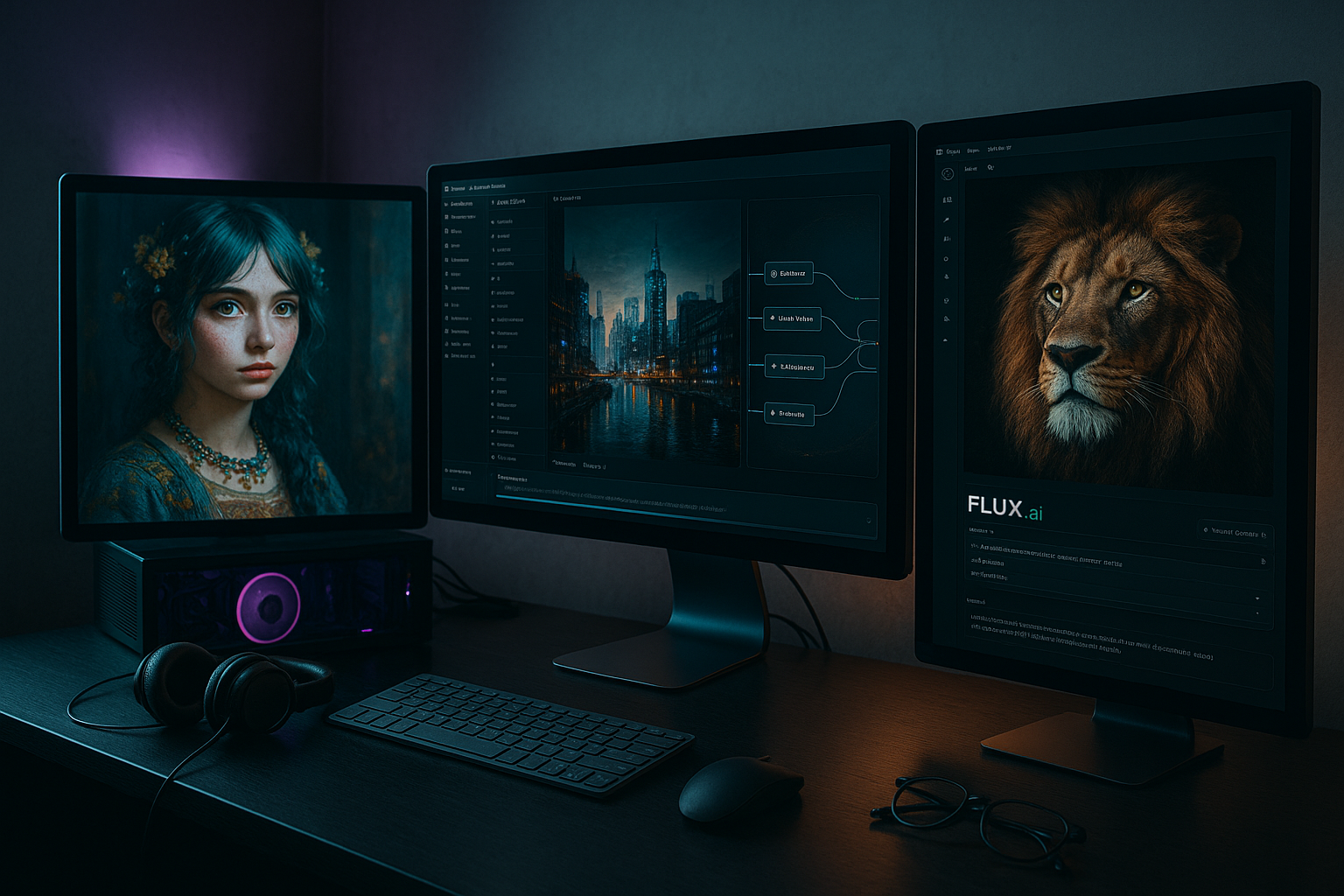AI Arms Race Heats Up: Google Challenges Nvidia, xAI's $230B Valuation, and Open-Source Image Synthesis

The AI landscape is shifting, and Google's Gemini 3 is challenging Nvidia's hardware dominance, offering businesses more choices and driving innovation. By understanding the impact of Gemini 3 on AI hardware, you can future-proof your infrastructure investments. Start exploring Google's TPUs as a viable alternative to mitigate supply chain risks and diversify your AI strategy.
Google's Gemini 3 vs. Nvidia: A New Era in AI Hardware?
The AI arms race isn't just about software; it's a full-stack battle extending deep into the silicon. Google's Gemini 3 is gaining significant traction, and its impact is rippling through the AI hardware landscape, potentially shaking up the dominance Nvidia has enjoyed. This shift is impacting market capitalization and forcing even Meta to consider alternative strategies for their AI infrastructure. Let's break down the key developments.
Google's TPU Challenge to Nvidia
For years, Nvidia has been the undisputed king of AI chips. But Google, with its Tensor Processing Units (TPUs), is mounting a serious challenge. These TPUs are custom-designed ASICs (Application-Specific Integrated Circuits) built specifically for the demands of machine learning workloads. They represent a significant investment by Google to optimize their AI infrastructure. This investment is now paying off. While Nvidia has struggled with supply constraints amid soaring demand for AI, Google is positioning itself to offer a viable alternative. The latest reports suggest Google's new TPU business aims to capture up to 10% of Nvidia's chip revenue, a bold target that underscores Google's confidence.
Meta's reported consideration of using Google's TPUs in their data centers further validates the growing viability of these alternative AI hardware solutions. It signals that even tech giants with massive resources are looking beyond Nvidia to diversify their AI infrastructure and mitigate supply chain risks. Meta also develops some open source models like AI at Meta.
Salesforce Pivots to Gemini 3
Beyond the hardware competition, the increasing adoption of Gemini 3 is a testament to its capabilities. A high-profile example is Marc Benioff's Salesforce Platform, which is migrating from ChatGPT to Gemini 3. This shift is a strong endorsement of Gemini's capabilities and highlights the competitive pressure in the large language model (LLM) space. This could be a sign of things to come. Companies are increasingly evaluating different AI models and platforms to find the best fit for their specific needs and, potentially, to avoid over-reliance on a single provider.
In conclusion, the rise of Google's Gemini 3 and its associated TPU ecosystem marks a pivotal moment in the AI landscape. It not only intensifies the competition for AI hardware supremacy but also empowers businesses with more choices, potentially leading to greater innovation and accessibility in the long run. These trends are also covered in AI News, where the latest advancements are constantly reviewed.
xAI's Massive $15 Billion Funding Round: An AI Investment Boom?
The AI world is buzzing after xAI, Elon Musk's artificial intelligence venture, announced a staggering $15 billion Series E funding round, rocketing its valuation to an eye-watering $230 billion. This monumental investment signals a clear intention: xAI is positioning itself to directly challenge OpenAI's dominance in the AI landscape. But is this a sign of healthy competition, or are we inflating an 'AI bubble' to unsustainable levels?
Fueling the AI Engine: Data Centers and GPUs
So, where is all this money going? According to xAI, the funding will be used to build out crucial infrastructure: primarily data centers and a massive stockpile of GPUs (Graphics Processing Units). These are the very lifeblood of modern AI. Just like a high-performance race car needs a powerful engine and a steady fuel supply, AI models need massive computational power and vast datasets to learn and operate effectively. The race to acquire the best AI talent is mirrored by the race to secure the hardware to train ever more capable models, much like the one used by Deepseek.
Data Centers: These facilities house the powerful servers needed to process and store the massive amounts of data required for AI training.
GPUs: Specialized processors designed to handle the complex mathematical calculations involved in machine learning.
Riding the Wave or Inflating the Bubble?
This massive investment in xAI underscores the intense investor enthusiasm surrounding the potential of artificial intelligence. However, some analysts are sounding the alarm, warning about a potential 'AI bubble'. These concerns arise from the increasingly high valuations of leading AI companies, including OpenAI and Anthropic, which seem to be detached from current revenue realities. It's a high-stakes game of chicken, where everyone is betting on future potential, hoping that AI will deliver on its promises sooner rather than later.
The question is whether the rapid growth and potential disruption justify the current valuations, or if we're setting ourselves up for a painful correction down the road.
Sky-High Valuations: A Look at the Top Players
The xAI funding round only adds fuel to the fire. To put things in perspective:
Company | Valuation (approx.) |
|---|---|
OpenAI | $80-90 Billion |
Anthropic | $18 Billion |
xAI | $230 Billion |
These figures illustrate the sheer scale of investment pouring into the AI sector. While the potential rewards are enormous, the risks are equally significant. As with any emerging technology, only time will tell whether these valuations are justified or whether a reckoning is on the horizon. This also puts pressure on these companies to deliver, and many turn to AI supercomputing to accelerate the development of models that will power the future.
Ultimately, xAI's massive funding round signifies more than just a financial transaction; it represents a pivotal moment in the ongoing AI arms race. It underscores the conviction that AI will reshape industries and societies, and it highlights the fierce competition to lead this technological revolution. Now, let's turn our attention to the evolving landscape of open-source image synthesis and the exciting developments happening in that space.
FLUX.2: Open-Source AI Image Synthesis Revolutionizes Generative AI

The generative AI landscape just got a whole lot more interesting with the arrival of FLUX.2, an open-source AI image synthesis model developed by Black Forest Labs. This launch signals a significant step forward for accessible and high-quality image generation, empowering both individual creators and larger enterprises.
Unleashing Open-Source Potential
Black Forest Labs has positioned FLUX.2 as a direct competitor to proprietary models like Midjourney, a powerful AI image generator known for its artistic and photorealistic results, and OpenAI's DALL-E. Unlike these closed platforms, FLUX.2 champions the open-source ethos, granting users unparalleled freedom to modify, distribute, and integrate the model into their own projects. This approach not only fosters innovation but also democratizes access to cutting-edge AI technology.
FLUX.2 boasts impressive capabilities. Key features include:
Multi-Reference Input: The model can synthesize images based on multiple reference images, enabling more nuanced and controlled generation processes.
High-Fidelity Output: FLUX.2 delivers images at a stunning 4-megapixel resolution, ensuring exceptional clarity and detail.
Nvidia GPU Optimization: The model is meticulously optimized for Nvidia GPUs, promising blazing-fast performance for users with compatible hardware.
By embracing open-source principles, Black Forest Labs is challenging the status quo and driving a new wave of innovation in the generative AI space.
Pro-Grade Power for Professionals
While the open-source version caters to a broad audience, Black Forest Labs also offers a pro-grade version of FLUX.2. This premium offering is designed for enterprise and creative users who demand even greater performance and support. The pro version unlocks additional features and optimizations, making it ideal for demanding professional workflows.
A European Powerhouse in AI
The emergence of Black Forest Labs and FLUX.2 underscores Europe's growing strength in the generative AI arena. As the AI landscape continues to evolve, expect to see further innovation and competition from European players, challenging the dominance of US-based companies. Keep an eye on our AI News section for more updates on the rapidly evolving world of AI.
FLUX.2's arrival marks a pivotal moment for open-source AI image generation. Its impressive capabilities, coupled with its open and accessible nature, promise to fuel creativity and innovation across various industries. It will be interesting to see how this offering from Black Forest Labs influences the development of other AI models in the future.
China's AI Scene: Affordable Models and Global Investment
China's AI landscape is rapidly evolving, marked by increasing accessibility, significant investment, and a unique approach to AI development.
Democratizing AI Through Affordable Models
One of the most striking trends in the Chinese AI scene is the drive towards affordability. Chinese AI developers are actively working to lower the barriers to entry by creating cheaper AI models. This "frugal AI" approach, as it's sometimes called, emphasizes efficiency and practicality, making AI solutions accessible to a wider range of businesses and individuals. For example, DeepSeek offers impressive capabilities at a cost-effective price point, contributing to the democratization of AI technology.
Unicorns and Download Milestones
Investment is pouring into the Chinese AI sector, as evidenced by the rise of new unicorns. Shanghai’s AI2 Robotics, a company focused on intelligent robots, recently achieved unicorn status, signaling strong investor confidence in its potential. At the same time, Alibaba’s Qwen app, showcasing the power of large language models, has exceeded 10 million downloads. This milestone reflects the growing adoption of AI-powered applications among Chinese consumers. To put it in perspective, Alibaba's Qwen stands as a testament to how AI is quickly being integrated into daily life, much like how one might use ChatGPT for various tasks, from answering questions to generating creative content.
Foreign Investment and 'Frugal AI'
Despite geopolitical tensions, foreign venture capitalists are showing renewed interest in Chinese AI companies. The attraction? Compelling valuations and the potential for high returns. This influx of capital is further fueling innovation and growth within the sector. A key characteristic of China's AI development is its 'frugal AI' philosophy. This approach focuses on creating practical and cost-effective AI solutions, rather than solely pursuing cutting-edge research with no immediate real-world application.
This emphasis on affordability and practicality could give Chinese AI companies a competitive edge in certain markets, particularly in developing countries where cost is a major consideration.
The Chinese AI scene presents a dynamic mix of affordability, innovation, and investment, setting the stage for further growth and competition on the global stage. As Chinese AI models become more accessible and powerful, they are poised to reshape various industries both within China and beyond, making it a space to watch closely in the ongoing AI News cycle.

AI Security Threats: Holiday Scams and Rising Cybercrime
The holiday season, a time for joy and connection, is increasingly becoming a playground for sophisticated AI-driven cybercrime. As we deck the halls, cybercriminals are leveraging the power of artificial intelligence to craft more persuasive phishing campaigns, create deceptive fake webstores, and execute elaborate holiday scams, making digital hygiene more critical than ever. This surge in AI security threats demands a heightened awareness and proactive defense.
The Rise of AI-Powered Scams
Attackers are no longer relying on crude, easily detectable methods. Instead, they're harnessing generative models to create highly convincing phishing emails and build fraudulent websites that closely mimic legitimate businesses. These AI-generated scams are becoming increasingly difficult to distinguish from the real thing. For example, think of receiving an email that appears to be from Grammarly, the popular AI-powered writing assistant, offering a special holiday discount. But upon closer inspection (or a moment too late), it directs you to a fake site designed to steal your credentials.
The sophistication of these scams is alarming. AI allows criminals to personalize attacks at scale, tailoring messages to individual users based on their known interests and online behavior.
This personalization dramatically increases the likelihood of a successful breach. It's not just email, either. Mobile phishing attacks are also on the rise, with SMS messages containing malicious links becoming a common tactic. Be wary of unsolicited texts promising deals that seem too good to be true – especially around the holidays.
Account Takeover Fraud and Automated Cybercrime
The FBI has reported significant financial losses attributed to account takeover fraud, a trend exacerbated by AI. Criminals use stolen credentials, often obtained through phishing, to access user accounts and conduct fraudulent transactions. Moreover, AI is enabling the automation of cybercrime. Instead of manually searching for vulnerabilities and exploiting them, hackers can deploy AI-powered tools to scan networks, identify weaknesses, and launch attacks with unprecedented speed and efficiency.
Staying Safe in the AI Era

Combating these AI security threats requires a multi-faceted approach. Individuals must practice rigorous digital hygiene, including using strong, unique passwords, enabling multi-factor authentication, and carefully scrutinizing all online communications. Businesses need to invest in advanced security solutions that leverage AI to detect and prevent attacks in real-time. Staying informed about the latest AI fraud tactics through resources like AI News is also important. The rise of AI-driven cybercrime is a serious concern, but by staying vigilant and proactive, we can protect ourselves and our communities from these evolving threats. The future of cybersecurity will undoubtedly involve an ongoing arms race between attackers and defenders, each leveraging AI to gain an edge.
Generative AI Hype vs. Productivity: Navigating the Bubble
The AI revolution is capturing headlines and investment dollars at an unprecedented rate, but is it all sustainable? As global spending on AI is projected to reach a staggering $2 trillion by 2026, a crucial question arises: are we witnessing genuine progress or simply inflating an AI bubble ripe for bursting? This surge in investment and enthusiasm has naturally ignited concerns about speculative bubbles, with some analysts questioning whether the hype surrounding generative AI is outpacing its actual productivity gains. You could use a tool like Runway, an applied AI research company advancing the creation of the next generation of creative tools, to test the productivity.
The AGI Debate and Contrarian Voices
Adding fuel to the fire is the ongoing debate surrounding Artificial General Intelligence (AGI). While many tout AGI as the ultimate destination for AI development, achieving human-level intelligence, not everyone agrees on its imminence or even its desirability. Yann LeCun, for example, holds a contrarian view, suggesting that the path to AGI is far more complex and uncertain than current narratives suggest. This perspective adds a layer of skepticism, urging a more measured assessment of AI's potential impact.
Investor Sentiment and Market Correction Anxiety
After enjoying record gains fueled by AI mania, some investors are beginning to reduce their risk exposure, signaling a potential shift in market dynamics. This move reflects a growing awareness of the potential downsides and the need for a more balanced portfolio strategy. Wall Street itself seems torn between the allure of AI's transformative potential and the looming possibility of a market correction. This tension highlights the inherent uncertainty and volatility associated with emerging technologies.
The Threat of 'AI Slop'
Beyond financial concerns, another worry is the proliferation of what's been dubbed 'AI slop' – low-grade, mass-generated content that floods the internet, diluting the quality of information and potentially hindering genuine creativity. This deluge of mediocre content raises questions about the true value and impact of AI-driven content creation, suggesting that quantity may be prioritized over quality. Tools like GPTZero, an AI detector, are designed to combat the 'AI slop'. As we embrace the possibilities of generative AI, it's crucial to navigate the hype with a critical eye, ensuring that productivity gains and genuine innovation are not overshadowed by speculative bubbles and the potential for low-quality content. Keeping up with AI News can help.

🎧 Listen to the Podcast
Hear us discuss this topic in more detail on our latest podcast episode: https://open.spotify.com/episode/2z869pLvxyoHtNtilJi5Qb?si=lqECI4PMRZCPb1KivvEEyw
Recommended AI tools

Explore, Navigate, and Connect Scientific Research

Collect customer feedback effortlessly

Uncover the narrative behind the numbers.

Empowering your investment decisions with AI

Reliable Reviews and Guides for AI Tools

Unlock Data Insights
About the Author

Albert Schaper is a leading AI education expert and content strategist specializing in making complex AI concepts accessible to practitioners. With deep expertise in prompt engineering, AI workflow integration, and practical AI application, he has authored comprehensive learning resources that have helped thousands of professionals master AI tools. At Best AI Tools, Albert creates in-depth educational content covering AI fundamentals, prompt engineering techniques, and real-world AI implementation strategies. His systematic approach to teaching AI concepts through frameworks, patterns, and practical examples has established him as a trusted authority in AI education.
More from Albert

